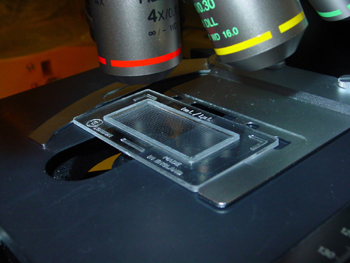Activity
Activity 2 - How to count?
Objective:
To introduce techniques used for quantification of algal cells.
Materials:
- compound microscope
- microscope slides / cover glass
- counting cells
- algal culture e.g. Chlorella sp.
Quantification:
Algal species vary in sizes. So choosing a suitable magnification on counting the different species becomes very important. The table below shows the recommended microscope working magnification for counting different size classes of microalgae.
ĹĄ
| ĹĄ | Size | Magnification |
| ĹĄ | 0.2 Üd2.0 um (picoplankton) 2.0 Üd20.0 um (nanoplankton) > 20.0 um (microplankton) |
1000x** 100 Üd400x 100x |
| ** With oil immersion |
ĹĄ
The method for counting microalgae depends on the sensitivity that observers want to achieve. Different methods for counting microalgae are shown below.
Summary of methods for quantification of microalgae using compound microscope
ĹĄ
| ĹĄ | Methods for quantification of microalgae |
Volume (ml) of sample required
|
Sensitivity (cells/l) | Preparation time |
| ĹĄ | Drop on slide |
0.02
|
50000 to 100000 | 1 min |
| ĹĄ | Sedgewick-Rafter cell (counting cell) |
1
|
1000 | 15 mins |
| ĹĄ | Palmer ÜdMaloney cell (counting cell) |
0.1
|
10000 | 15 mins |
| ĹĄ |
|
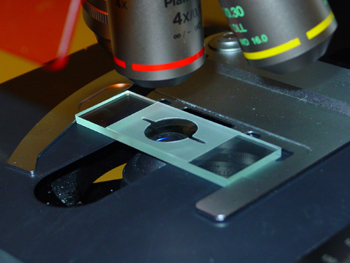 |
|
Sedgewick-Rafter cell
|
Palmer ÜdMaloney cell
|
ĹĄ
Method 1 ÜdDrop on Slide
This is the simplest method to estimate the density of microalgae. One drop of seawater is approximately equal to 0.02ml, if you find one algal cell in a drop of sample, the estimated density is 50,000cells/L.
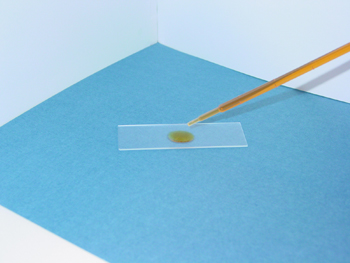 |
Mix the sample by covering the lid and shaking gently. Use a dropper to add a drop of sample on to a glass slide. Cover the drop of sample with a glass slid by lowering the slid. Place the slide on the stage of microscope and observe slowly. |
|
Place a drop of sample on the slide.
|
ĹĄ |
ĹĄ
Method 2 - Sedgewick-Rafter cell
Sedgewick-Rafter cell is widely used for quantification of phytoplankton with a volume of 1mL [50mm(length) x 20mm (width) x 1mm (height)]. The bottom plate of the Sedgewick-Rafter cell is divided into 50 columns and 20 rows forming 1000 squares altogether.
Algal cells per mL = Number of cells counted x 1000 / Number of squares observed
Remark: Sedgewick-Rafter cell can be purchased from biological supplies stores at about HK$200
ĹĄ
| Filling the cell | |
| ĹĄ | |
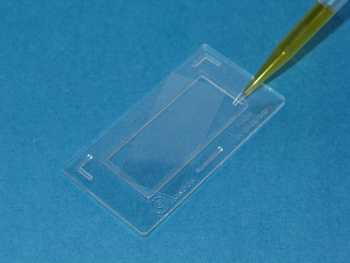 |
Step 1 The cover glass placed diagonally across the cell. |
| ĹĄ | ĹĄ |
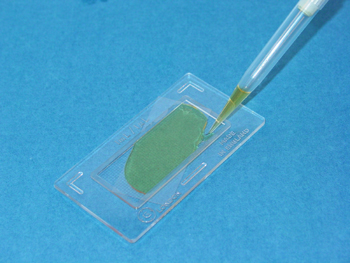 |
Step 2 Add the sample at one corner into the cell with plastic dropper |
| ĹĄ | ĹĄ |
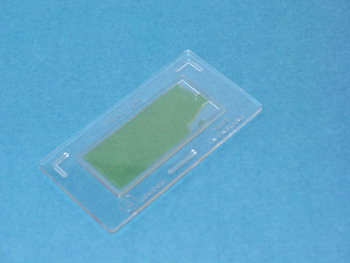 |
Step 3 Turn the cover glass slowly to cover the cell under. The cell contains 1ml of sample. Do not leave air bubbles in the counting cell. |
| ĹĄ | ĹĄ |
ĹĄ
Counting of algal culture
Observe the sample and count the density of algal cells under microscope. Try to compare the results of cell density of the same algal sample by using different counting methods.
ĹĄ
| BackĹĄ | Back to Top |
